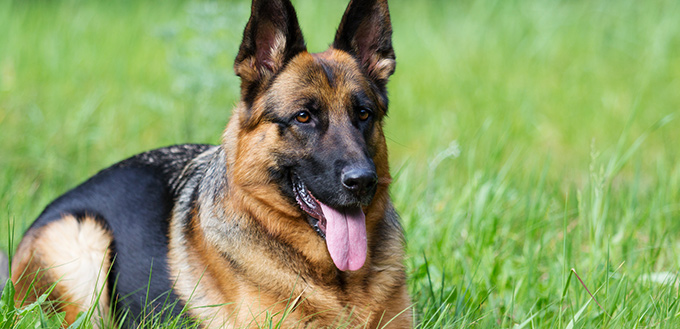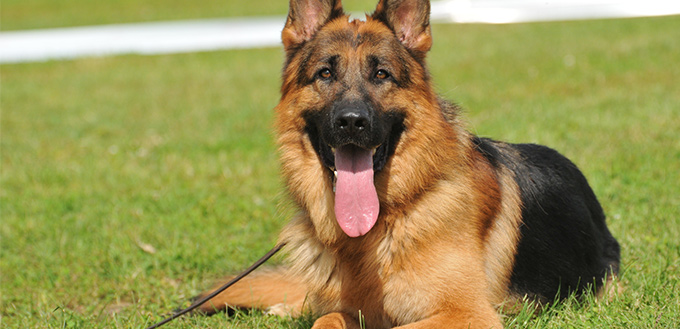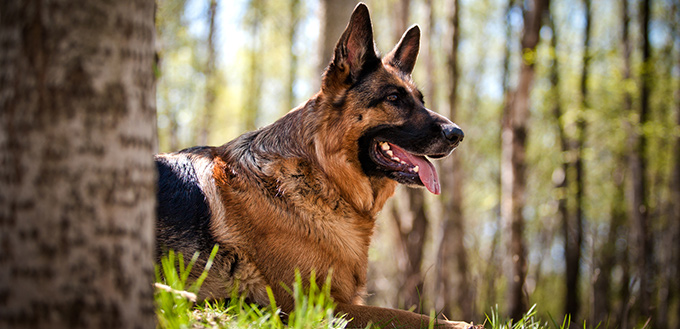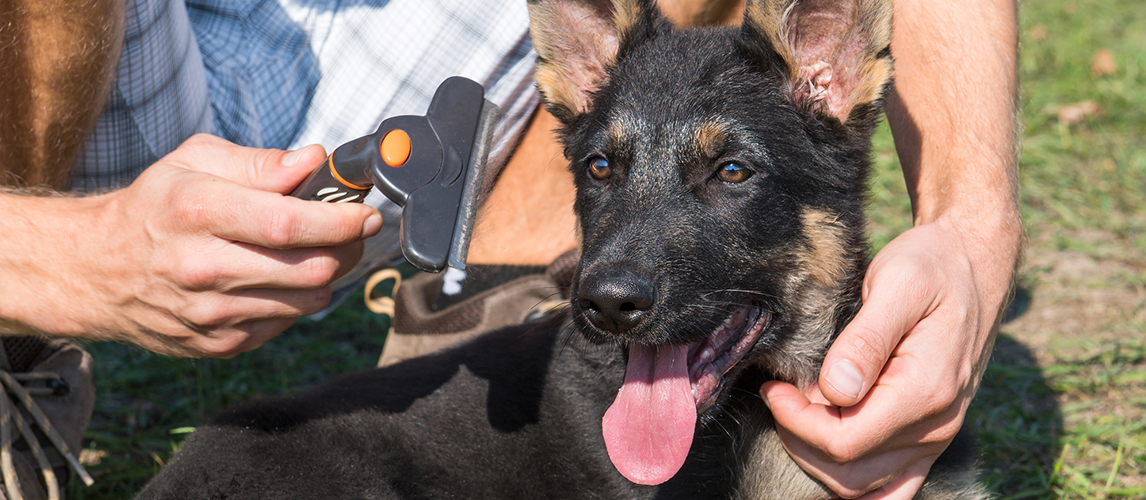The ever-obedient, confident, and very loyal German Shepherd is one of the planet’s most popular breeds of dogs. Aside from being the dependable members of law enforcement, search and rescue, and military organizations around the globe, they make very faithful companions. No one can ever question the loyalty of a German Shepherd. And despite its imposing size and commanding presence, these dogs are very friendly and gentle on kids, making them one of the best dogs to have in a growing family.
Smart, confident, and courageous, German Shepherd Dogs (GSDs) are currently classified by the American Kennel Club in the Herding Group of dogs and ranks second in the organization’s most popular breeds. German Shepherds have a life expectancy of anywhere between 9 and 13 years, although it is not unusual to see some dogs outliving their breed standards.
Instantly recognizable with its black saddler and tan- or red-colored body and limbs, the GSD has a domed forehead, black nose, strong jaws, and a long, albeit square-cut muzzle. Perhaps one of the most characteristic features of a GSD is its large ears standing erect, although these are often pulled back with movement. It has a self-assured and intelligent look in its brown, medium-sized eyes.
The stance of a German Shepherd dog (GSD) is one of grace and refinement. Instead of the clearly sharp angles in other dog breeds, GSDs come with easy, gentle curves when viewed from the side. It is this naturally smooth flowing of their body contours that give the GSD amazing speed and agility. Their natural gait is one of an easy-and-free trot, although they can easily flip a switch and you’d see them dashing like a greyhound.

Quick Facts
- Rin Tin Tin, the movie world’s first canine superstar, cemented the position of the German Shepherd as one of the world’s most easily recognizable dog breeds.
- The average male German Shepherd can grow up to 26 inches and weigh between 65 and 90 pounds. Females can grow up to 24 inches and weigh between 50 and 70 pounds.
- During the First World War GSDs were renamed by the Americans as Shepherd Dogs because they didn’t want the dog to be associated with Germany. At the same time, the English also renamed the GSD as Alsatian Wolf Dogs. The name Alsatian is still used by many Europeans to this day.
- German Shepherds are also called ‘German Shedders’ because of their natural tendency to shed a lot. They have medium-length fur in a double-coat setup. It is the undercoat that sheds heavily especially during spring and autumn. They are also known to ‘blow’ – shedding a lot at once that people describe it as a snowstorm.
Temperament
Confident, fearless, and direct; these are ideal qualities of a German Shepherd. It is intelligent, devoted, fun-loving, easy to train, and a very devoted dog especially if its parents have good temperaments, too. You can ensure the best in your German Shepherd if it is trained and socialized early on to become familiar with different people, sounds, and sights.
GSDs are working dogs and as such require physical exercise and a good dose of quality mental stimulation. While they can be successfully raised in kennel situations, they will still require plenty of interaction from their human masters. They want to work. There is nothing more fulfilling for a German Shepherd than be able to perform even the most mundane of tasks. It enjoys plenty of walks or even going on a hike. Play ball with your GSD and you’ll find out its stamina is a lot greater than yours. Involve it in dog sports and it will easily bring home the bacon every time.
Exercise and mental stimulation is a must for GSDs: lest they grow bored, lonely, and destructive. As such, they are best reserved for pet parents who are themselves smart and active and who can provide these dogs with focused attention, training, and exercise. Above all, German Shepherds love lots of one-on-one time with their human masters.
You may also like our article on the Best Dog Food for German Shepherd.

German Shepherds are very intelligent. Studies show that they can perform a trick 95% of the time just by teaching them the trick only once. Mastery of a certain trick can be achieved in as little as 3 to 5 sessions whereas other dog breeds will typically require a few weeks to several weeks just to master a single trick alone. GSDs rank third among the world’s most intelligent dogs following Border Collies and Poodles. However, if you think that German Shepherds will perform the trick on their own because they’re intelligent, think again. They are intelligent only when they are trained early on. This makes puppy training an absolute must. Remember, being gifted with intelligence is nothing if they cannot put this intellect to work.
One of the most interesting aspects about German Shepherds is that they have this reputation for being aggressive. Their stance, size, and body language coupled with their instinctive protectiveness make them excellent deterrents and watchdogs. While this reputation is quite accurate, there is actually another side to it that makes the GSD such a revered member of the family. GSDs are known to be very friendly with kids as well as other pets especially when they grew up together. They’re very affectionate with their families, too.
Things You Should Know
Getting a German Shepherd requires a lot of careful consideration. These are very active, smart, intelligent dogs that require the same qualities from their human masters or at least have a fundamental understanding of their needs. To help you decide whether the GSD is for you or not here are a few things you need to know about this dog breed:
Trainability
German shepherds are highly intelligent dogs. They’re smart and can easily be trained using the correct techniques and positive reinforcement. Animal behavior experts say that GSDs can easily learn a trick in as few as 3 repetitions, with many GSDs showing 95% accuracy of the behavior with just one repetition. That being said, training a GSD should start right at puppyhood. Learning the different steps and techniques of puppy training is crucial to harnessing the full trainability of GSDs. Equally important are the use of pet treats and other positive reinforcers.
German shepherds are primarily motivated by the ability to work. They are originally bred as sheepdogs so one can only expect that they live to work. This is the very essence of their intelligence. They need something to work on so that they can use their cognitive capabilities. As such, their training is usually designed in such a way that it looks and feels like work for GSDs. They love scent detection, herding, and other physically-demanding activities that are best reserved for dogs that have exceptional stamina.
Grooming
German shepherds are aptly called “German shedders” because of their predisposition to shed heavily, especially in spring and fall. During these times of the year, GSDs require frequent bathing and brushing of their coat to help remove loose hair. A dog shedding brush may also be used to facilitate the removal of the excess hair. Whether or not it is spring or fall, German shepherds still require weekly brushing to help promote healthier and cleaner coats. You may also want to get a heavy-duty pet hair vacuum cleaner to help get rid of loose hair in your home.
Check out our guide on the Best Brush for German Shepherds.
Health issues
While German shepherds are known to be very sturdy, they do present with health problems that are very common in large dog breeds. For instance, GSDs are prone to the development of hip dysplasia, a condition whereby the hip joints failed to develop in a more normal manner leading to the thigh bone not fitting properly into the joint capsule of the hips. When the condition is not managed this can lead to arthritis and can severely impact the quality of life of your German shepherd. Remember that GSDs are highly active work dogs. Problems in their joints will impair their mobility; hence, their activities will also be impaired.
Another major cause of concern among GSD owners is degenerative myelopathy which is a lot similar to multiple sclerosis. What happens is that the GSD develops a progressively slow, creeping paralysis of its hindquarters. Other health conditions that GSDs are known to have include heart murmurs, cardiomegaly, heart valve diseases, visual problems, epilepsy, hemangiosarcoma, bleeding disorders, exocrine pancreatic insufficiency, and immune-mediated diseases.
A German shepherd is generally a good choice for a dog if you’re looking for a hound that is:
- Affectionate with its family
- Incredibly kid-friendly
- Very easy to train
- Smart and intelligent
- Handsome, regal, and well-built
- Very eager
- Loyal and faithful
- Obedient and protective
- Fearless, hardworking, and strong-willed
While these characteristics can easily make a German shepherd the perfect choice for many dog-lovers, they are not ideal for someone who:
- Doesn’t know how to be the leader of the pack
- Doesn’t have the time to train the dog
- Cannot spend at least 30 minutes of exercise every day with their dog
- Cannot devote at least 15 minutes of quality one-on-one bonding time with their dog
- Doesn’t like to brush and bathe their dog regularly and frequently especially during spring and fall
- Doesn’t like the idea of having plenty of loose hair on the carpet, furniture, and other items in the house
- Lives in very hot temperatures since the double-coat nature of GSDs can lead to overheating

History
The modern German Shepherd has its humble beginnings from 6 different breeds of European sheep herding dogs. These included the Italian Bergamasco Shepherd, the Lupino del Gigante, the Cane de Pastore della Lessinia e del Lagorai, the Cane Paratore, the Pastore d’Oropa, and the French Berger Picard. By the middle of the 19th century, attempts were already made to standardize the different breeds. From these efforts came the characteristics that are desired from a sheep herding dog: intelligence, keen sense of smell, strength, and speed.
By 1891, the Phylax Society was formed to institutionalize the standards of sheep herding dogs in Germany. While the group did not last, some of its former members persevered in their quest for standardizing the breed that will become the quintessential sheep herder in Germany. One of these ex-members is Max von Stephanitz who firmly believed in the idea that dogs should be specifically bred for working. He admired Germany’s native sheepdogs for their ability, strength, and intelligence, but this did not satisfy him to consider the breed as the ideal working dog.
In 1899, all these changed when von Stephanitz was introduced to Hektor Linksrhein, a sheepdog that is the result of selective breeding that lasted several generations. Hektor’s beauty, intelligence, loyalty, and strength were all that von Stephanitz wanted in the perfect working dog. He bought Hektor from its owner and renamed it Horand von Grafrath. Soon after, von Stephanitz established the Verein fur Deutsche Schaferhunde or the Society for the German Shepherd Dog. This formally introduced the German Shepherd Dog to the world with Horand officially being recognized as the very first German Shepherd.
Horand became the progenitor of all modern German Shepherds. The dog was introduced in the US towards the early parts of the 1900s. They were instantly loved by dog-lovers because of their highly-adaptable, intelligent, attractive, and hardworking nature. The very first GSD registered with the AKC was Queen of Switzerland in 1912. It was the following year that the German Shepherd Dog Club of America was formally established.
Unfortunately, the outbreak of the First World War saw the decline in the popularity of the breed as they were inadvertently correlated with the enemy. But the war only cemented the GSD’s unique characteristics as a working dog. It braved artillery fire, tanks, and landmines just so it can bring much-needed supplies to the German frontlines.
It was after the war that Rin Tin Tin and Strongheart revived the popularity and favorability of the breed to the American dog-loving society. The breed’s popularity peaked with the crowing of Sieger Pfeffer von Bern as the AKC’s Grand Victor for 1937 and 1938. Unfortunately, with World War II and the growing anti-German sentiment, the breed’s popularity again took a hit.
After the Second World War, their popularity steadily increased, culminating in the number 2 spot of the AKC’s most popular breeds, second only to the Labrador, in 2016.
The German shepherd continues to wow dog-lovers everywhere. Their proud stance, characteristic coat, and their irrefutable reputation for intelligence, speed, strength, loyalty, dedication, protectiveness, and faithfulness all make the GSD a great dog to have for pet parents with the same characteristics.
Dog Food Mat
Sources:
- German Shepherd Dog – The American Kennel Club







